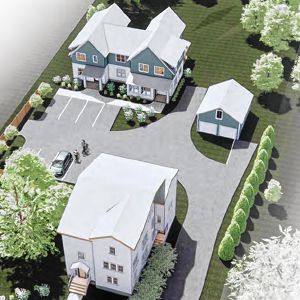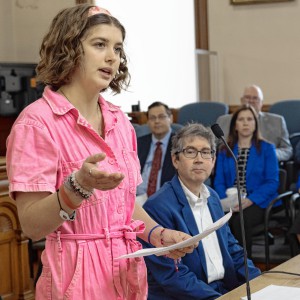Lilacland: Pelham property inspires local painter
| Published: 05-25-2017 12:10 PM |
Jim Lumley learned to appreciate nature’s beauty at an early age.
His parents, the late Mabel and Al Lumley, planted extensive lilac bushes on the family’s Pelham property, which for decades has been a popular visiting site for lilac lovers, picnickers and people who simply enjoy the variety of color. The property’s name says it all: Lilacland.
Lumley, who’s now 75 and has run Lilacland for about 30 years, was so inspired by the colors and light that he took up landscape painting as an adult, first as a hobby and then very seriously.
When he was about 40, he sold his real estate company and went to study in Cape Cod with Henry Hensche, a noted impressionist painter who in turn had studied with one of the first American impressionists, Charles Hawthorne, in the early 1900s.
And after years of study, and then displaying his work, including still lifes, in galleries on the East Coast as well as in the South, Lumley remains hard at work: painting “en plein air” to capture a scene “as nature intended,” as he puts it, under natural light.
“It’s really important to capture local color and the changes in light,” he said during a recent interview at Lilacland, where several people were strolling the grounds, admiring lilac plants that were in full bloom.
“For me, direct observation is the only way to try and paint a natural setting,” Lumley added. “Photographs can make a record of specific time and place” but can’t account for changing light, he noted.
And Lumley’s not one for using a sketch or a photograph simply as a basic framework for painting an outdoor scene in imaginary colors: “I want to paint the colors I see.”
Article continues after...
Yesterday's Most Read Articles
 A Waterfront revival: Two years after buying closed tavern, Holyoke couple set to open new event venue
A Waterfront revival: Two years after buying closed tavern, Holyoke couple set to open new event venue
 3-unit, 10-bed house in backyard called too much for Amherst historic district
3-unit, 10-bed house in backyard called too much for Amherst historic district
 Settling in on the streets: Six months on, Division of Community Care finding niche in Northampton
Settling in on the streets: Six months on, Division of Community Care finding niche in Northampton
 Valley writers shine in initial round of Mass Book Award competition: 12 area authors and author/illustrators long-listed for 2024 awards
Valley writers shine in initial round of Mass Book Award competition: 12 area authors and author/illustrators long-listed for 2024 awards
 UMass basketball: Matt Cross announces he’s transferring to SMU for final year of eligibility
UMass basketball: Matt Cross announces he’s transferring to SMU for final year of eligibility
 Democracy’s defense marches on: Constitutional lawyer, activist daughter highlight annual Law Day event
Democracy’s defense marches on: Constitutional lawyer, activist daughter highlight annual Law Day event
At Lilacland, in his gallery that’s in an old barn open to visitors, he has many of his works on display (he builds most of the frames himself). From local landscapes like the Fort Hill River to the Holyoke Range, and some farther afield, like the Blue Ridge Mountains, his paintings exhibit a rich palette that has some impressionistic touches but has a layered style all his own.
As Lumley writes on his website, “I use color to show the major planes of light striking a landscape at specific times of day … I also use different colors, instead of shades of the same color, to show how the light changes shapes within the landscape [and] to show ... how horizontal planes recede into the distance.”
In “Mt. Holyoke at Last Light,” for instance, the local peak is centered in the painting, while distinct, undulating ridges take up the foreground. Above Mt. Holyoke, the sky is bisected by alternating lines of clouds and light, from the yellow of sunset just over the mountain to the darkening sky at the painting’s top.
Lumley, who also crafts wooden bowls from downed trees on his 11-acre property, studied with a number of teachers over the years. But his primary instructor and biggest influence was Henry Hensche, who was in his 80s when Lumley went to study with him at the Cape School of Art in Provincetown.
The school had a rich pedigree. It was founded in 1899 by Charles Hawthorne, one of the country’s earliest impressionist painters and teachers. What was then called The Cape Cod School of Art was one of a number of outdoor painting programs established around that time, primarily in New York and New England, to teach European impressionism, which had first appeared in France about 25 years earlier.
Hensche, a native of Germany who came to the U.S. with his family around 1910, saw some paintings by students of Hawthorne at a Chicago exhibit in 1916; he was so struck by the colors that he came to Provincetown a few years later, at about age 20, where Hawthorne, by most accounts, became his mentor.
After Hawthorne died in 1930, Hensche began teaching at the Cape Cod School — a practice he kept up well into his 80s. His work has generally been celebrated for its mix of impressionism and modernism and some distinctly American themes, and as a teacher he has been recognized for advancing “the ideals of color as the basis for painting, as opposed to tonal painting,” as one description of his work explains.
“I learned so much from Henry about light and color,” said Lumley. After spending a few summers at the Provincetown school, he added, he also began assisting Hensche in various ways, including teaching some of the beginning students.
“He said, ‘You’re getting better at this, let’s have you take on some more,’ ” Lumley said.
Hensche’s primary message, Lumeley added, was “how to capture different local colors in different conditions of light ... simple in concept, challenging to achieve.”
Lumley said Hensche, who died in 1992, came to stay with him in Pelham for six months between 1986 and ’86 after Hensche’s wife, Ada, died. “To the end, Henry remained bright and and an inspiration to us all,” he said in a follow-up email. “He is missed.”
In a sense, Lumley and his wife, Margaret, continue to celebrate Hensche’s spirit — and the spirit of Mabel and Al Lumley — by maintaining the 170 colorful varieties of lilacs on their Pelham property, as well as other shrubs and trees such as dogwood trees, whose white blossoms offer a striking contrast to the lilacs.
Lumley says his parents planted numerous flowering shrubs and trees on the property after World War II, then added various fruit trees in the early 1950s. His father, the athletic director at Amherst College, enlisted the help of his friend Charles Cole, Amherst’s president at the time, for the work, which they did more out of enthusiasm than any background in horticultural work.
“But my dad was a very quick study,” Lumley noted.
When many of the fruit trees didn’t survive, the Lumleys had their property tested by agricultural specialists at the University of Massachusetts Amherst, who suggested lilacs could thrive in the somewhat alkaline soil. They have indeed thrived, Lumley said, though he and Margaret plant new varieties some years to make up for plants that don’t survive.
As he gave a tour of the property — the season is at its end — Lumley pointed to some of the invasive plants, such as sumac and Asiatic bittersweet, that he and Margaret have to cut back from the lilac bushes; that, and clearing brush and cutting the grass, are part of their regular groundskeeping routine.
But Lumley says the artistic inspiration he continues to get from the property, and the enjoyment visitors get from viewing it, are well worth the work. He still works part time as a residential realtor — he got back into the business in the 1990s — but he also finds time to attend drawing sessions at Amherst College and to teach drawing and painting during the summer at Lilacland.
“This land has given me a lot,” he said.
Steve Pfarrer can be reached at spfarrer@gazettenet.com.
For more information on Jim Lumley’s art, visit www.jameslumley.com.

 Easthampton author Emily Nagoski has done the research: It’s OK to love your body
Easthampton author Emily Nagoski has done the research: It’s OK to love your body Earth Matters: Honoring a local hero: After 40 years, Hitchcock Center bids farewell to educator and creative leader, Colleen Kelley
Earth Matters: Honoring a local hero: After 40 years, Hitchcock Center bids farewell to educator and creative leader, Colleen Kelley Valley Bounty: Delivering local food onto students’ plates: Marty’s Local connects farms to businesses
Valley Bounty: Delivering local food onto students’ plates: Marty’s Local connects farms to businesses Let’s Talk Relationships: Breaking up is hard to do: These tools can help it feel easier
Let’s Talk Relationships: Breaking up is hard to do: These tools can help it feel easier
